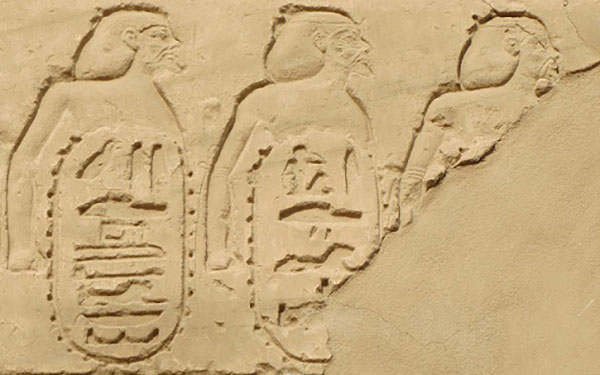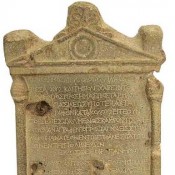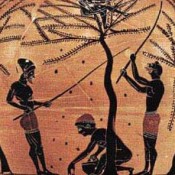The Österreichische Akademie der Wissenschaften / Österreichisches Archäologisches Institut has organized an online conference on “Sheshonq (Shishak) in Palestine”. Organized by Dr Felix Höflmayer ([email protected]<
Register in advance for this webinar:
<https://oeaw-ac-at.zoom.us/
Pharaoh Sheshonq I (c. 943-923 BCE) is traditionally viewed as the founder of the 22nd Dynasty. What makes this king a corner stone for Egyptian-Levantine interrelations as well as Biblical Studies and archaeology alike is his report about campaigning in the southern Levant. According to 1 Kings 14:25-28 and 2 Chronicles 12:2-9, Pharaoh Shishak looted the temple in Jerusalem in the 5th year of Rehoboam taking with him plentiful bounty.
When the inscription and great list of Sheshonq I on the south wall of the Bubastite Portal in Karnak were discovered, scholars immediately connected them with the narrative of the Hebrew Bible. Seemingly a perfect corroboration of the Biblical narrative, the royal inscription in Egypt offered one of the earliest external synchronisms for Biblical chronology. The link between the Egyptian inscription and the verses in the Hebrew Bible was perceived as even stronger and more reliable, after a fragment of a stela bearing the name of Sheshonq I was found in the excavations of the Oriental Institute of the University of Chicago at Megiddo.
In due course, Sheshonq I’s campaign became an unavoidable peg in the chronological system of Iron Age Israel and seemed only too useful for dating destruction layers in archaeological sites. In the light of the importance and wide-ranging implications of the Egyptian inscription, it is therefore important to review what we actually know and try to explore whether or not this inscription, its topographical list and the Biblical narrative refer to the single same event. A fresh, critical, and dispassionate view of Sheshonq I in Palestine is definitely needed.
Programme
31 May 2021, Philology
Opening
09:00 – 09:15: Andreas Pülz (Austrian Academy of Sciences) & Roman
Gundacker (Austrian Academy of Sciences): Welcome Address & Introduction
Shishak in the Bible
09:30 – 10:00: Emanuel Tov (Hebrew University of Jerusalem): Different
Textual
Traditions about Sheshonq-Shishak in the Hebrew Bible
10:00 – 10:30: Andreas Vonach (University of Innsbruck): Rewritten Bible
and Historicity: “Pharaoh Shishak” as Testcase for the Composition of
Deuteronomistic History
10:30 – 11:00: Wolfgang Zwickel (Johannes Gutenberg-University Mainz):
Shishak’s Campaign – An Alternative View
11:00 – 11:30: Coffee break
Onomastics and Linguistics
11:30 – 12:00: Francis Breyer (University of Bonn): The Berber Origin and
Reception of Sheshonq I and Other Libyan Pharaohs
12:00 – 12:30: Roman Gundacker (Austrian Academy of Sciences): Sheshonq
and Shishaq: Philological and Linguistic Perspectives
12:30 – 14:00: Lunch break
Historiography and Romance
14:00 – 14:30: Matthew J. Adams (W.F. Albright Institute of Archaeological
Research): King-Lists, Chronographers, and Synchronisms: Historiographical
Observations Concerning Shishak of Egypt
14:30 – 15:00: Ivan A. Ladynin (Moscow State University): Sesonchosis the
Conqueror: A Topos of the Graeco-Egyptian Tradition and Its Origin
15:00 – 15:30: Coffee break
Sheshonq’s Topographical List
15:30 – 16:00: Annik Wüthrich (Austrian Academy of Sciences): A
Re-Examination of the Triumph Inscription of Sheshonq I
16:00 – 16:30: Julien Cooper (Beijing Normal University Zhuhai Campus):
Between History, Geography, and Epigraphy: The Topographical List of
Shoshenq and Remarks on Its Historicity
16:30 – 17:00: Yigal Levin (Bar Ilan-University): Sheshonq’s “Lower
Register”
and the Hazerim of the Negev
17:00 – 18:00: Discussion
1 June 2021, Archaeology
Opening
09:15 – 09:30: Felix Höflmayer (Austrian Academy of Sciences): Introduction
Stratigraphy and Sciences
09:30 – 10:00: Katharina Streit (Austrian Academy of Sciences): Destruction
Horizons and Shoshenq’s Campaign to the Southern Levant – The Iron Age
Chronology Debate Revisited
10:00 – 10:30: Lyndelle Webster (Austrian Academy of Sciences): What
Radiocarbon Can (and Can’t) Say about Sheshonq’s Campaign to Palestine:
A Review of the Present State of Research
10:30 – 11:00: Coffee break
Sheshonq in the South
11:00 – 11:30: Erez Ben-Yosef (Tel Aviv University): Sheshonq (Shishak)
in Palestine: Some Comments in Light of Recent Research in the Arabah
Valley
11:30 – 12:00: Gunnar Lehmann (Ben Gurion-University) & Revital Golding-Meir
(Ben Gurion-University): Shishak in the Negev
12:00 – 13:30: Lunch break
Sheshonq in the North
13:30 – 14:00: Bernd Schipper (Humboldt University of Berlin): Egypt and
Byblos in the 10th and 9th Centuries BCE. A New Evaluation of the Sheshonq I
Fragmentary Statue
14:00 – 14:30: Zachary Thomas (Tel Aviv University): Solomon, Sheshonq and
Early Iron Age Megiddo: An Antipositivist Perspective
14:30 – 15:00: Shirly Ben-Dor Evian (Israel Museum Jerusalem): The Sheshonq
Fragment from Megiddo: A Different Interpretation
15:00 – 15:30: Coffee break
Modelling History
15:30 – 16:00: Israel Finkelstein (Tel Aviv University): Sheshonq I
Campaign to
Canaan: Chronological, Archaeological and Historical Comments
16:00 – 16:30: Amihai Mazar (Hebrew University of Jerusalem): What Kind of
a Country Did Shoshenq Encounter?
16:30 – 17:00: Felix Höflmayer (Austrian Academy of Sciences): Sheshonqin
Palestine: A Minimalistic View
17:00 – 18:00 Discussion





